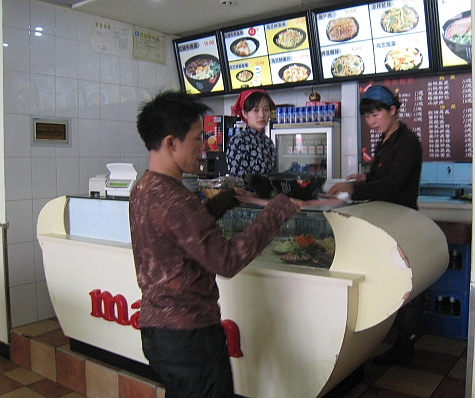Beef noodle soup is common fare for Beijing. I was a little unsure about risks of eating uncooked vegetables, but Eric recommended the pickled cucumbers.
Out on the main street, we saw the partitioned streets common in Beijing: outer lanes for bicycles and taxis loading/unloading, and inner lanes for the main flow of traffic.
We passed a vendor selling pineapple on a stick, and Eric decided he wanted one.
We passed by Beijing Haidian Hospital. At that time, we didn’t know that it was the appointed medical facility for Olympics athletes.
The Haidian Theater is prominent at a main intersection, and a landmark that we passed on multiple taxi trips.
Crossing the street on a pedestrian overpass, the air pollution was visible on that Monday.
In the street below, there was a lot of construction. I presume that this might have been for the new subway interchange.
Looking the other direction from the pedestrian overpass, we were unsurprised to see yet another Beijing traffic jam.
The plaza was terraced, so we climbed some steps to an upper level. From the there, the modernity of Beijing was illustrated one of many glass buildings.
Looking down from the upper level, the pedestrian overpass was high above the street traffic between the malls.
From the overlook, the expansiveness of wide-open spaces left an impression. Beijing is the capital city of China, so architecture is scaled large.
Turning around to return the way we came, I let Eric go ahead so that the scale of distances could be appreciated.
Back down on the ground level, we walked around and found this nice-looking building. It’s a restaurant architected in a more traditional Chinese style.
The entry of the Haidian Carrefour springs up from the plaza. The escalators weren’t working when we arrived, so we took the stairs down two levels.
As we entered the store, it’s clear that the Chinese have learned about the hypermarche from the French.
Past the electronics section was a large selection of refrigerators. I shouldn’t have been surprised at the number of Chinese brands.
The next aisle was a display of washing machines.
Beijing is on the edge of a desert, so a large selection of humidifiers is appropriate.
The bicycles were mostly at a functional, rather than prestige level. I saw a variety of styles of folding bicycles.
On the other side of the store was displays of linens and comforters.
Eric decided to pick up a buckwheat pillow while he was there. The pillow is twice the size of the one I’ve owned since my days in Vancouver.
Shoes on sale are stacked up in a display.
Beside the better shoes is a size chart.
In a less advanced consumer market, the retailer can add value through customer service. The warranty on shoes offered by Carrefour was explicitly posted.
If the store wasn’t already large enough, it’s on two floors. We rode the escalator up, with our shopping cart.
Northern China eats more wheat than rice. The selection in the bakery department rivals any western supermarket.
Watermelons were already in season in March.
Dragonfruit certainly has a colourful exterior. I’ve never been a big fan of the interior.
In ready-made foods was a large display of trotters. They’re not something that I would normally eat.
Behind glass was a variety of baked goods and buns unfamiliar to me.
In North America, we’re not accustomed to having a wide selection of seaweeds.
The seafood department offers live fish in running water.
Ground meats are available in self-service quantities.
There’s lots of choice in the candy displays.
In the freezer cases, we saw different types of sausages.
Liquor is readily available in the supermarket.
The checkout lanes are as we know in developed countries.
Since Haidian is known as a high-tech centre, Eric took me by the electronics buildings for a quick look.
The Haidian Street sign leaves no question where you are.
In one of the towers, vendors compete for customers passing by their stalls.
Eric said to keep moving, and we got on the escalator up.
Lenovo is a Chinese company which has taken over the Thinkpad brand.
Laptops are wrapped in plastic to keep sticky fingers away.
We exited the tower by another door. Eric said that the next tower was similar in layout.
On the way back to the hotel, we saw a lower-tech version of customer service: computer technicians pedaling to their customers, with all of the necessary equipment on the cart behind.
This short afternoon walk in the Haidian district reinforced my impressions of Beijing as a big city. The wide sidewalks and streets reflect the order that should be expected in a capital city. For a human being on foot, though, the city has an intimidating size.

